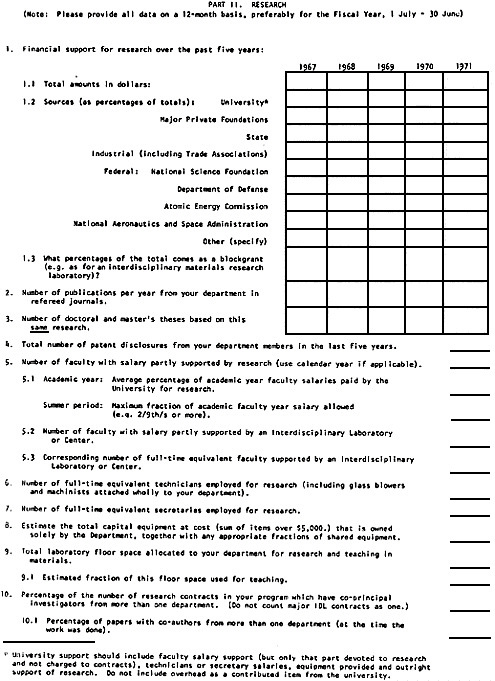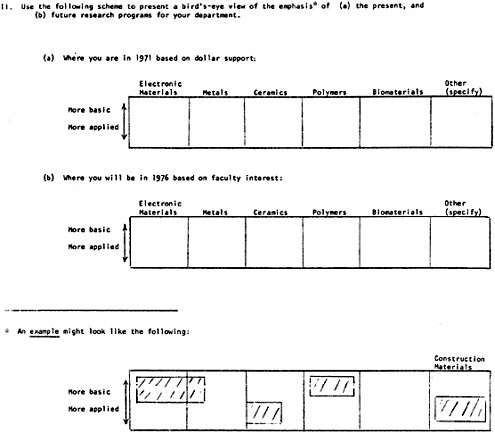APPENDIX 7B Some Examples of New Materials-Science Curricula
|
a. University No. 70. Name: |
Solid State Science (Total Ph.D.’s so far: 120) Enrollment 50–75 |
This is an interdisciplinary program that cuts across departmental and collegiate lines. Faculty from various departments and with different backgrounds (e.g., chemistry, physics, fuel science, ceramics, electrical engineering, computer science, etc.) participate in the program. Master of Science and Doctor of Philosophy degrees are offered to students interested in pursuing an integrated and an interdisciplinary program of study encompassing both the necessary scientific fundamentals of chemistry, physics, and mathematics and their technological and engineering applications.
The program of courses taken by a student interested in the structure, properties, and behavior of solid materials must necessarily cut across two or more disciplines. The relevant subject matter has been grouped into four areas: (1) the structure of solids (crystal chemistry and structure determination); (2) theory related to the solid state (physics, chemistry, and mechanics); (3) properties of solids (optical, electrical, magnetic, mechanical, thermal and chemical); and (4) reactions of solids (phase equilibria, reaction mechanisms, reaction kinetics, and surface reactions). In addition there is the polymer science option which stresses appropriate aspects of organic polymers. The program of study is guided by a study panel consisting of members from the Solid State Science and related faculty.
The M.S. degree requires a total of 18 credits of course work (plus 12 in research), including substantial work in at least two of the above areas. The Ph.D. requires approximately 40–45 credits in course work plus research (no specific number of credits is required), distributed so that one discipline is encompassed in depth but with credits from all four areas. A thesis is required for both degrees.
|
b. University No. 75 Name: |
Ph.D. in Polymer Science (Total Ph.D.’s so far:____) Enrollment_______ |
Advanced polymer programs leading to the doctorate and master’s degrees are offered in both the Chemistry Department and the Materials Division. In addition, a polymer engineering option is presently being instituted in the Materials Engineering Curriculum leading to either a Master of Science or Master of Engineering degree. Undergraduate electives in polymers are frequently chosen by students in chemistry or chemical engineering curricula. Also, chemical engineering master’s projects in polymers are available within
the Professional School Program of the School of Engineering.
Formal courses in polymers are offered as follows:
Introduction to Polymer Physics
Introduction to Polymer Chemistry
Physical Chemistry of Solid Polymers
Physical Chemistry of Polymer Solutions
Organic Chemistry of High Polymers
Physical Properties of Polymers I and II
Polymerization Kinetics
Molecular Characterization of Polymers
Polymer Rheology
Polymer Science Laboratory
Viscoelasticity
Special Topics in Polymer Chemistry
The introductory courses are open to undergraduate and graduate students and are prerequisite for enrollment in the advanced courses. In addition to these courses, doctoral candidates in the polymer program frequently elect courses in the thermodynamics, instrumental analysis, physical chemistry, fluid mechanics, solid-state physics, x-ray diffraction and crystallography, rheological mechanics, applied mathematics, chemical reaction engineering, and fracture.
|
c. University No. 48 Name: |
Polymer Science and Engineering (Total Ph.D.’s so far_______) Enrollment__________ |
The program offers a Ph.D. degree with thesis and two master’s degrees, with and without thesis. The degree without thesis involves 30 credits of course work. Normally, a baccalaureate degree in physics, chemistry, or engineering is required to enter directly the advanced degree program. Course scheduling is arranged to accommodate regular full-time graduate students as well as industrial employees who wish to matriculate in the evening. A series of four core courses are required for all M.S. candidates. They are recommended for all Ph.D. candidates, who will generally build upon the material presented in these courses in preparation for passing the Cumulative Examination requirement. The core courses are as follows:
|
General: |
PSE |
501 Introduction to Polymer Sci. |
3 credits |
|
PSE |
502 Polymer Sci, Lab. |
2 |
|
|
Polymer Science: |
PSE 793 |
Organic Polymerization Reactions |
3 |
|
PSE 794 |
Physical Chem. of High Polymers |
3 |
|
|
Polymer Engineering: |
PSE 795 |
Rheology |
3 |
|
PSE 796 |
Polymer Processing |
3 |
The overall Ph.D. curriculum, not including thesis, might be comprised of the following course credits:
Core courses (17) + PSE and technical electives (12) + seminar (4) + research proposal (2) = 36. For example, specific sample Ph.D. programs could be the






